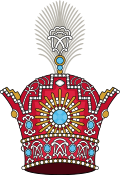This article needs additional citations for verification. (January 2020) |
| Part of a series on |
| Imperial, royal, noble, gentry and chivalric ranks in West, Central, South Asia and North Africa |
|---|
 |
Taluqdars or Talukdar (Bengali: তালুকদার, Hindustani: तालुक़दार/تعلقدارtāluqdār; taluq Arabic: تعلق "estate" + dar Persian: دار "owner"), were aristocrats who formed the ruling class during the Delhi Sultanate, Bengal Sultanate, Mughal Empire and British Raj. They were owners of a vast amount of lands, consistently hereditary,[1][2] and had revenue and judicial powers.[3]
Being powerful peers, similar to those of Europe in the Middle Ages, after the decline of the Mughal state the Taluqdaris were to withstand the revenue collectors of the Colonial Powers while also bringing given number of villages under their dominion, and thus, according to many historians, the rapid development and enhancing power and wealth of the Taluqdaris during the early 19th century caused tremendous difficulties and concerns to the British East India Company.[note 1] The majority of the Taluqdaris constructed themselves enormous mud fortified towers throughout tropical forests and maintained immense bodies of armed affinities.[4]
The Taluqdars of Oudh were baronial,[5][6][7] with some representing the ancient families.[8] In other cases, the historical equivalent in Britain is similar to a member of the landed aristocracy, or perhaps a Lord of the Manor.[9] In contemporary usage, the term is often regarded as a noble tribe and clan,[10] although it may convey some diverse meanings in different parts of the Indian subcontinent.[11] It is mentioned that throughout Oudh till Bihar, there was a presence of large numbers of Rajput Taluqdars and they played an important role in 1857 in the region.[12]
- ^ "Talukdar Meaning | Best 1 Definitions of Talukdar". www.yourdictionary.com.
- ^ Luscombe, Stephen. "The British Empire, Imperialism, Colonialism, Colonies". www.britishempire.co.uk.
- ^ Muttalib, M. A. (1988). Administration of Justice Under the Nizams, 1724-1948. State Archives, Andhra Pradesh. p. 170. OCLC 22242042.
- ^ Gupta, Gautam. 1857 The Uprising. 8123022994.
- ^ Sir John William Kaye (1876). A history of the Sepoy war in India, 1857-1858. Vol. 3. W. H. Allen & Co. p. 423.
- ^ James Kennedy (1993). Life and Work in Benares and Kumaon, 1839-1877. Asian Educational Services. p. 218. ISBN 9788120607514.
- ^ Princes and Peasants; or, The Rent Difficulty in Oudh. Thacker's Indian Directory. 1865. p. 32.
- ^ Chanana, Priyanka (2013). "Caste Ties, Allodial Rights and Colonial. Administration in Oudh During Summary Settlement and After 1858: The Taluqdar Association and the British Policies Upto 1870s". Proceedings of the Indian History Congress. 74: 458–469. JSTOR 44158846.
- ^ "A chronic inability of taluqdars to meet the revenue demands". Economic and Political Weekly. II. 1997.
- ^ Sisson, Richard; Wolpert, Stanley, eds. (2006) [First published 1988]. Congress and Indian Nationalism: The Pre-independence Phase. University of California Press. p. 408. ISBN 978-0-520-06041-8.
taluqdar: large landlord in UP
- ^ Chisholm, Hugh, ed. (1911). . Encyclopædia Britannica. Vol. 26 (11th ed.). Cambridge University Press. p. 386.
- ^ Thomas R.Metcalf (8 December 2015). Aftermath of Revolt: India 1857-1970. p. 299. ISBN 9781400876648.
Cite error: There are <ref group=note> tags on this page, but the references will not show without a {{reflist|group=note}} template (see the help page).